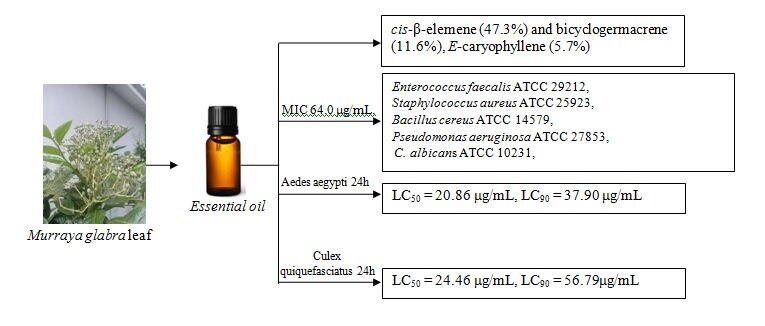JOURNAL 2779
Records of Natural Products
Year: 2023 Issue: 5 September-October
p.938 - 946
Viewed 1694 times.
-
Do Ngoc Dai

-
Le Thi Huong

-
Nguyen Cong Truong

-
Vo Thi Dung

-
Truong Quang Ngan

-
Nguyen Dihn Tuong

-
Isiaka Ajani Ogunwande

GRAPHICAL ABSTRACT

ABSTRACT
The present result showed that sesquiterpene hydrocarbons (78.3%) were the main class of compounds present in the essential oil hydrodistilled from the leaves of Murraya glabra (Guillaumin) Swingle from Vietnam. The major sesquiterpene compounds of the essential oil are cis-β-elemene (47.3%) and bicyclogermacrene (11.6%). In addition, E-caryophyllene (5.7%), (E, E)-α-farnesene (3.4%), ar-curcumene (3.3%) and α-zingiberene (3.0%) were the other sesquiterpenes present in sizeable amount. Oxygenated monoterpenes were not identified in the essential oil. The essential oil from the leaves of M. glabra displayed antibacterial activity against Enterococcus faecalis ATCC 29212, Staphylococcus aureus ATCC 25923, Bacillus cereus ATCC 14579, and Pseudomonas aeruginosa ATCC 27853, as well as anti-candidal action against C. albicans ATCC 10231, each with Minimum Inhibitory Concentration (MIC) value of 64.0 mg/mL. The corresponding median inhibitory concentration (IC50) values were 32.56 mg/mL, 32.58 mg/mL, 32.99 mg/mL, 32.45 and 32.44 mg/mL, respectively. Essential oil from the leaf of M. glabra exhibited larvicidal activity against Aedes aegypti and Culex quiquefasciatus with median lethal concentrations (LC50) values of 20.86 μg/mL and 24.46 μg/mL, at 24 h, respectively. The lethal concentration required to kill 90% of population exposed (LC90) values at the same test periods were 37.90 μg/mL and 56.79 μg/mL, respectively. The essential oils may be further considered and investigated as a source of natural products.
KEYWORDS- Murraya glabra
- gram-positive bacteria
- gram-negative bacteria
- Aedes aegypti
- Culex uinquefasciatus